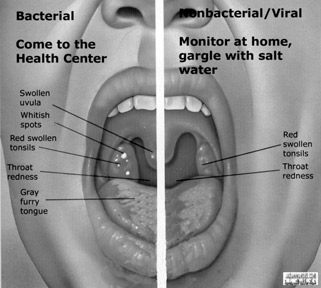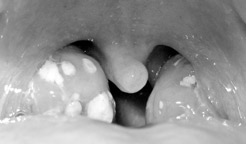
Personal hygiene can overcome laryngitis
by Dhaneshi YATAWARA
 There could have been numerous instances where we screamed at the top
of our voice. A few weeks ago we witnessed many instances of politicians
addressing meetings at the top of their voice. There could have been numerous instances where we screamed at the top
of our voice. A few weeks ago we witnessed many instances of politicians
addressing meetings at the top of their voice.
There could have been numerous instances in our lives where we got
scared and screamed. The hoarse voice would last a few days. However, we
all think this is temporary and common. According to ENT specialists it
is poor vocal hygiene.
Have you ever heard of vocal hygiene? Well, this is not exactly what
we understand as oral hygiene. If you have not heard of it, it is time
for you to pay some attention. Vocal hygiene is all about protecting
your throat or the larynx or the commonly known `voice box' by carefully
using your voice.
Laryngitis, can be either due to a viral or bacterial infection or
lack of vocal hygiene. Laryngitis is an inflammation of the mucous
membrane lining the larynx or the `voice box'. It causes hoarseness in
the voice and possibly the temporary loss of speech. According to
doctors laryngitis, is in two forms - acute and chronic. Laryngitis that
lasts only for a few days is supposed to be acute while it can persist
over weeks and months when it is chornic.
Ear, Nose and Throat (ENT), Specialist Chandra Jayasuriya of the
Colombo National Hospital highlighted what vocal hygiene, is all about.
She told the Sunday Observer that "Laryngitis is the inflammation of
vocal cords mainly due to infection and just like tonsillitis we can
contract viral or bacterial laryngitis".
 |
|
The human larynx in a
diagram |
There are other causes of laryngitis than infections, she said. There
is smokers' laryngitis. Certain people contract laryngitis due to
refluxes caused by gastritis or other upper gastrointestinal diseases.
This is called acid laryngitis. Another illness is singers' or teachers'
nodes caused by the overuse of vocal cords.
Larynx
Larynx is in our throat, in the upper part of the respiratory tract.
It has several functions to perform in our body. One is voice
production, the other protects the airway. When the vocal cords are
closed it prevents aspiration of unwanted things into the lungs.
When a person gets laryngitis it is very important for him to protect
his or her larynx.
"If one overuses his larynx when there is an inflammation, it can
cause scaring on one's vocal cords which results in loosing the quality
of one's voice," Dr. Jayasuriya warned.
"Voice abuse is another major problem that causes laryngitis," she
said. Overuse of voice is unnecessary levels of loudness or basically
screaming at the top of your voice, will tend to contract an illness
called singers' or teachers' nodes. These are non-cancerous.
This largely affects professional voice users, such as teachers,
lecturers, singers and politicians; they are like nodes one gets in
one's palms which are called karageta in Sinhala when the hands are
overused due to hard labour.
Medical treatment
Different types of laryngitis need different types of treatment, Dr.
Jayasuriya said. Laryngitis due to bacterial infection needs to be
treated medically and patients affected with laryngitis due to smoking
must give up the habit of smoking. "If these smokers don't quit their
habit they will face more serious consequences, the worst being cancer.
They can end up with laryngeal cancer and as such smokers' laryngitis
is dangerous," Dr. Jayasuriya said. For Acid laryngitis due to refluxes
caused by gastritis can be treated with anti-reflux medicine. "Gastritis
is not good for your vocal cords. The acid can burn your vocal cords and
the gastritis should be kept under control," she said.
Catarrh or severe sinusitis should be properly treated and kept under
control because the infected sinus material can flow into the larynx,
especially during sleep.
Voice rest
Voice rest is the main treatment for people with laryngitis due to
overuse of their vocal cords. The speech therapy is essential to treat
such patients. We need to be taught how to use our voice properly.
Breathing exercises and voice training mostly done by singers is
essential to protect the vocal cords which eventually saves the voice.
Any person using his voice must know how to use his voice without adding
strain to it.
 |
|
Position of the larynx
in the respiratory tract |
"The process is that a person can talk only when he or she breathes
out. The vocal cords vibrate with the exhaled air. If a person doesn't
inhale air properly he or she cannot exhale too well. To maintain proper
vocal hygiene a person must breathe properly," Dr. Jayasuriya said.
Hence in speech training, a person is taught to breathe in and out
properly.
Unless a person inhales an adequate amount of air, the vocal cords
get exhausted. Shallow breathing exhausts the vocal cords and as such a
person should take a deep breath and say a few words during a breath.
There should be enough space between words for the lungs to be filled
with an adequate amount of breath at moderate loudness.
Everyone has experienced screaming in their lives. Everyone knows the
difficulty in the throat after screaming and the horrible hoarse voice
one gets after a screaming. A scream can damage the vocal cords and
there will be bleeding into the vocal cords. So while teaching, singing
or in addressing the public a person should not scream at the top of his
or her voice. For proper vocal hygiene a person should speak at a
moderate volume, less number of words per breath.
"All teachers, singers or politicians don't get these nodes. If a
person uses his voice properly there won't be any chance for the nodes
to form," Dr. Jayasuriya said.
Medical advice for such professionals is that they should use
amplification when necessary. "Some people think using amplification
methods are an insult to their profession. Those are mere myths," she
said.
"Teachers or those addressing large crowds during workshops or
meetings, must be fully prepared beforehand so that they can use their
illustrations instead of speaking. It will be a more interesting and
effective mode of teaching rather than merely explaining using words,"
she said.
Vocal health
The key to vocal health is to use the minimum number of words. The
time period a person uses his or her voice, is what matters.
If a person doesn't rest the vocal cords enough they tend to get
exhausted. "Many of these professionals rest their voice only when they
are sleep. People must take a break in between," she said.
According to Dr. Jayasuriya taking sips of water or any such method
like taking small amounts of bees honey, eating 'Welmee' or 'Nelli'
fruit or even sugar free chewing gum helps to keep the throat,
especially the vocal cords moist. When the vocal cords are kept moist it
reduces friction between the vocal cords.
According to the specialist even clearing your throat can damage the
vocal cords. While brushing teeth some people are in the habit of
clearing the throat vigorously and gargling, which is bad. "Such action
traumatises your vocal cords," she said.
The need to clear the throat arises as phlegm flows in to the throat.
"A person must treat the problem that causes irritation in the throat,
be it either catarrh or sinusitis, by meeting a doctor. Clearing the
throat is not the solution," Dr. Jayasuriya said.
Tonsillitis
Though there are many patients with laryngitis, tonsillitis is more
commonly seen among people. Tonsillitis is the inflammation in the
tonsils due to bacterial infection.
The symptoms a person with tonsillitis experiences are sore throat,
yellow spots on tonsils, difficulty to swallow due to pain, node or
lumps in the throat. The painful tonsillitis can disrupt the daily
routine of a person.
"If a person gets more than six tonsillitis per year for two
consecutive years we perform tonsillectomy - that is the removal of
tonsils. If the frequency is less than that we try medical treatment,"
she said.
 |
|
Tonsilitis - different symptoms of the
bacterial and nonbacterial/viral infection |
Throat swab and full blood count are conducted to confirm the
infection. The antibiotic Penicillin is effective for tonsillitis, Dr.
Jayasuriya said.
"If very severe infection persists the patient may need to get
admitted to hospital and undergo a course of penicillin given
intravenously. On average there are four to five admissions per month at
the National Hospital," Dr.Jayasuriya said.
Usually tonsillitis is not so acute. Some even go to work while they
are ill. If the normal medical treatment does not answer the patient
should be given intensive penicillin treatment.
We tend to ignore a sore throat and adopt a home remedy, gargle and
get over the illness. Does this mean we are wrong? Is every sore throat
considered tonsillitis?
We can get tonsillitis with viral infections as well, Dr. Jayasuriya
said. Even with the common cold we can get a sore throat but it is
different from acute tonsillitis which is due to bacterial infection.
With a viral infection the throat gets inflamed and reddish. Viral
sore throats are quite common and self-limiting, she said. Even a common
cold is self-limiting. But in this case the yellow spots are absent.
"With the symptoms, a doctor can say whether it is a bacterial or viral
infection but to confirm we need to do the swab test or get a full blood
count," she said.
Though we call it sengedi in Sinhala it is actually the lymphoid
tissue, Dr. Jayasuriya said. The lymphoid protects the human body from
germs entering. Tonsils are bigger in children. In children lymphoid's
function is essential but as a person grows older its importance gets
reduced and thus it is rudimentary in adults. "Considering its
importance we don't recommend tonsillectomy for every child.
Only if it is confirmed we decide to do tonsillectomy because if the
recurrence continues it can lead to rheumatic fever and glomerular
nephritis," she said. (Glomerulonephritis also known as the glomerular
nephritis is the inflamation of the glomeruli, or the small blood
vessels in the kidney.)
Another aspect of poor vocal hygiene is betel chewing, which is
closely associated with Sri Lankan traditions.
 |
|
Severe tonsilitis due to bacterial
infection with whitish/yellowish spots on tonsils |
Though offering betel is a steadfast custom in our culture, chewing
betel is a major cause for many oral problems including cancer. "The
tobacco in the betel as well as arecanut contains cancer causing
substances. Whether done as a habit or not, chewing betel is not
hygienically acceptable," Jayasuriya said.
Drink plenty of water when you are ill even though it may seem to be
painful. This will ensure that you don't become dehydrated.
The next best thing would be to avoid excessive swallowing or
coughing because it will irritate your vocal cords. Practise good
personal hygiene. This will enable an easy recovery, she said.
Dr. Chandra Jayasuriya, ENT Consultant
Surgeon,Colombo National Hospital has more than 25 years experience in
the medical field. She completed her training in ENT surgery in Sri
Lanka in 1996 and received overseas training in the United Kingdom in
Tamasinde Acute Care, Ashton-Under-Lyne.
She is the founder President and the present
Secretary of the Sri Lanka Laryngectomy Association. She trains
post-graduate students in Otolaryngology at the Post Graduate Institute
of Sri Lanka.
Leprosy can be cured
by Nadira GUNATILLEKE
In 2009 there were 1875 new Leprosy patients reported from Sri Lanka
and 48 percent of them were from the Western Province. The Eastern
Province recorded the second highest percentage (15 percent). The
highest number of patients are reported from the Colombo Municipal
Council, Director, Anti Leprosy Campaign, Dr. Mrs. T. S. Liyanage said
at a seminar conducted by the Health Education Bureau.
According to Dr. Liyanage, this is only the tip of the iceberg and
the actual number of leprosy patients in Sri Lanka can be much higher
than this figure. There are two types of leprosy. One of them is
non-infectious and the other type is infectious. The infectious type is
on the increase in Sri Lanka at present. Colombo, Gampaha, Kaluatara,
Matale, Polonnaruwa, Trincomalee, Ampara, Kalmunai and Batticaloa are
the most affected areas.
Dr. Kaushalya Kasthuriarachchi said leprosy is a curable disease and
there are two types of treatment. Under one treatment plan, the patient
needs to take two drugs for six months uninterruptedly and under the
other plan the patient needs to take three drugs for a period of 12
months.
Early diagnosis and following the complete treatment plan will cure
the disease completely without causing any deformities. The disease does
not spread through the patients who take medical treatment. Treatment
available at state hospitals is free.
Dr. Shantha Hettiarachchi said that Pale, white or reddish skin
patches, loss of sensation, skin nodules and lumps, painless wounds,
inability in closing eyes are some of the symptoms of leprosy. If the
number of patches on the skin is less than 5 it is non infectious type
PB and if the number of patches is over 5 it is infectious type MB.
Treatment plans depend on the type. Leprosy spread through air
born/droplet and the incubation period is 2 to 3 years. There is social
stigma related to leprosy because it is just another disease that can be
completely cured through treatment.
Spicy peppers raise body temp and burn calories
by Susan Brady
The sweat that beads up on the foreheads of spicy pepper aficionados
just may be the key to weight loss associated with the consumption of
jalapenos, habaneros, and serranos. While not everyone can tolerate such
hot culinary fare, those peppers can be beneficial to your waistline, at
least in a small way.
A member of the nightshade family, peppers contain capsaicin, a
chemical compound that causes the pain receptors in your mouth to send
urgent messages to your brain to do something...quick.
 The brain then responds by pumping up the adrenaline levels,
increasing your heart rate, and causing you to perspire. It is these
reactions that help to burn calories. The brain then responds by pumping up the adrenaline levels,
increasing your heart rate, and causing you to perspire. It is these
reactions that help to burn calories.
A recent study at the UCLA Center for Human Nutrition took a small
group of 34 volunteers and split them into two groups. The control group
got a placebo pill, while the active group received pills containing
dihydrocapsiate (DCT), a version of capsaicin.
The pills were taken prior to each meal. Each volunteer had their
energy expenditure monitored after eating and researchers found that
those volunteers taking the DCT had the highest expenditure, almost
twice that of the control group. The DCT participants also burned more
fat than their counterparts.
Although the average American consumes almost 6 pounds of chili
peppers per year, many cannot tolerate the heat of the higher-capsaicin
peppers, such as the jalapeno, habanero, and serrano.
While removing the white pith and seeds can help reduce the burn,
it's not enough to eradicate it entirely. All peppers, from sweet bells
to pepperoncini to poblano to cayenne, have some level of capsaicin but
the hotter the pepper, the higher the reaction and therefore more energy
expended in eating and digesting it.
Because the study had such a small group of participants, and all
were on a low-calorie liquid weight-loss diet to begin with, the results
may be different from the average individual with a full-calorie solid
food diet. But, there is some merit to the results and further studies
are needed to verify results and to find an alternative to the
tongue-burning, forehead-perspiring peppers that many of us cannot
tolerate.
Healthnews |

